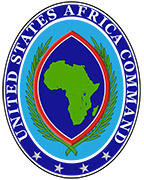Written by Sgt. Ange Desinor
13th Public Affairs Detachment
 Monrovia, Liberia – What started off as a simple medical waste drop off, turned into a tour of the operations of a medical laboratory. Once a research facility, it’s now been retrofitted to accommodate testing of blood samples from patients believed to have Ebola.
Monrovia, Liberia – What started off as a simple medical waste drop off, turned into a tour of the operations of a medical laboratory. Once a research facility, it’s now been retrofitted to accommodate testing of blood samples from patients believed to have Ebola.
Soldiers of the 36th Engineer Brigade took a tour at the Liberian Institute for Biomedical Medical Research, during Operation United Assistance mission, December 7th, Monrovia, Liberia.

The statues around the building are of chimpanzees that were used during the research back in the 70s.
“All the cages used to have chimpanzee’s in them,” said Schaecher, as he led the Soldiers around the facility.
The chimpanzees are now on a nearby island called Monkey Island. That’s where the retired chimpanzees go.
“There are at least 60 to 100 chimps down there,” said Schaecher.
Looking around and hearing about the history, Sgt. 1st Class Eddie Valdueza, a San Diego, California, native and a senior medic, was intrigued.
“I was amused by the whole compound and the history behind it,” said Valdueza. “To know that it still exists, and they test and do studies on Ebola and other diseases, really amazes me.”
Schaecher showed Soldiers the first step when potential Ebola samples come into the lab. He showed them a sheet has to be filled out and the procedures for accepting the samples.
He continued upstairs and into a room.
“We bring about 15 to 20 tough boxes with us every time we go on a mission,” said Schaecher, pointing to various boxes full of equipment. “We have groups of three that come out about every three to four weeks on a rotation. This is my second time out here.”
Safety and precautions are taken very seriously.
This is a collaboration between the U.S. Army Research Institution and Infectious Disease and the National Institute of Health as well as different organizations, said Schaecher.
Photo Gallery








